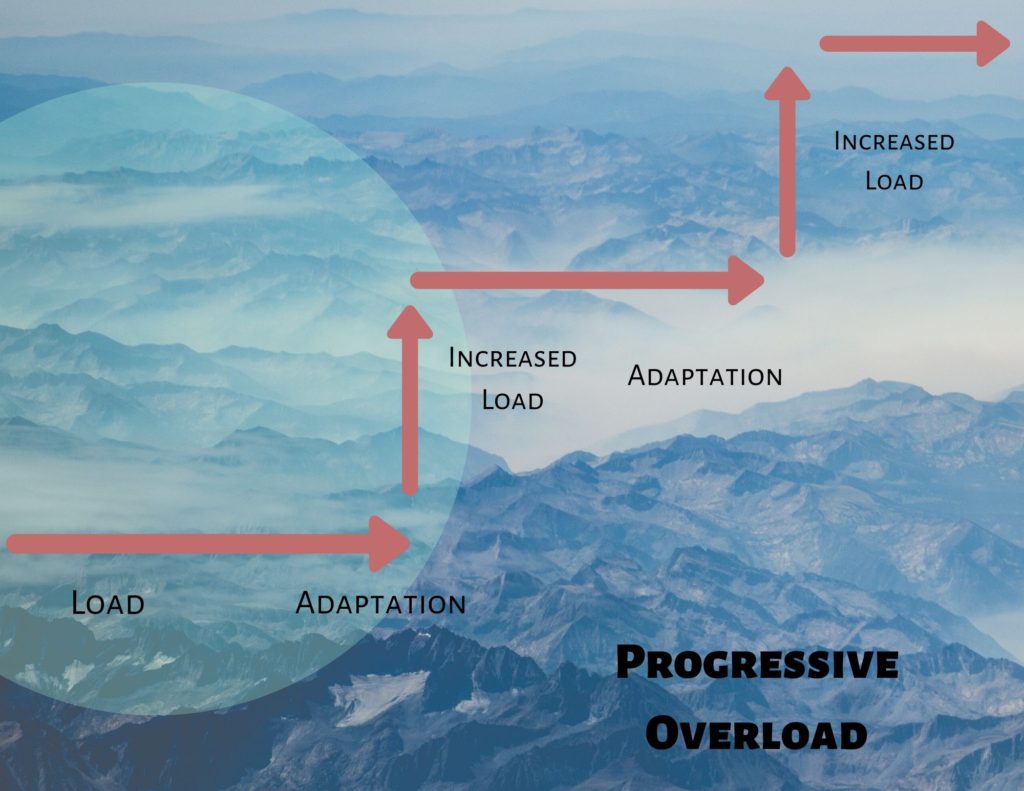As an avid gym-goer, there is something I come across quite often that really makes me cringe. Let me set the scene… You see someone doing bench press with 135 lbs, then overhead press with 50 lbs dumbbells, then onto bicep curls with the 80 lbs dumbbells. Now, you go back to the gym the next day and what do you see? The same guy benching 135, pressing the 50’s, and curling the 80’s. This goes on and on for weeks. Same exercise routine, same weight. You start to notice that he isn’t making any progress or any change in his body, yet he’s there for an hour everyday!

So, why isn’t he seeing any ‘gains’? He is putting the same strain on his muscles week after week instead of challenging them. He is not utilizing the most important factor in weight training: progressive overload! Now let’s look at exactly what progressive overload is.
What is it?

Progressive Overload is exactly how it sounds; progressively overloading your muscles. The Progressive Overload Principle means continuously increasing the demands on your musculoskeletal system in order to see changes and growth in strength, muscle size, and endurance. In simpler terms–increasing the amount of tension/stress you put on your muscles during training. By pushing your muscles to lift more than they previously have, you are promoting muscle tear and repair which results in growth. Skeletal muscle grows in response to weight training, but in order to continue growth and avoid ‘plateau’ you must place greater demands on them over time. If you don’t challenge your muscles, they have no reason to grow and adapt.
Getting stuck in your comfort zone during training often results in a plateau. This is because your muscles are now used to the amount of stress you have been placing on them and they have no reason to change. The human body will not change unless forced to. Progressive overload is almost the same as becoming complacent in your job. Once you know the routine, it’s easy to hit autopilot and cruise through the day, not actually trying your hardest or living up to your potential.
Methods to Overload
- Increase Resistance- This is the easiest way to overload your muscles and promote muscle growth. Simply, lift more weight that you did last time! If you bench pressed 135lbs last week and were able to get 5 sets of 15 reps, add 5-10lbs and do the same rep scheme. Add more weight than previously lifted.
- Increase Reps- If you are used to doing 4 sets of 10 reps for your program, try 4 sets of 12-15 reps, or 5 sets of 10 reps. Adding these extra reps will overload your muscle by putting more tension on them than usual. Adding more reps=higher demand.
- Decrease Rest- Decreasing your rest intervals demands your body to do the same amount of work in less time. This will require your body to become more efficient during anaerobic exercise.
- Increase Volume- Volume is simply sets x reps x resistance. Since we already discussed increasing resistance and reps, the easiest way to progressively overload your muscle using volume is to increase the amount of sets you preform.
- Increase Frequency- If you work back once a week and want to see increased growth in muscle, add a second day of back exercises to your week. Train the muscle more frequently, and you will put more stress on it, causing it to tear and repair for growth.
- Increase Intensity- Increasing intensity is rather vague. For progressive overload, increasing intensity is basically going past technical failure. For this you could preform forced reps, assisted reps, half reps, static holds, negative, drop sets, etc. Increasing intensity is beneficial, but works best when with a trainer or a partner.
Implementing Progressive Overload
Now that you know what progressive overload is, the benefits of it, and how to change up your routine, it’s important to start implementing it. Before you decide to add any of the changes listed above, make sure you have the correct form and range of motion in an exercise. For beginners it is important to first complete exercises with body weight. This will set you up for proper range of motion and form. Never up your weight until your lifting form is correct. Often, people implement progressive overload and believe they’ve gotten stronger, when in reality their range of motion has diminished or their form has been thrown out. If you are uncertain about form or how to properly overload, always consult with a competent trainer.
When progressive overload is the goal, I believe it is important to track your workouts. This could be with a journal or an app. Be sure to correctly record the amount of sets, reps, weight, and rest completed in order to help yourself overload the next week.
As always, the way you overload should fall in line with your goals. If you’re looking for an increase in strength, increase overall volume. If you’re looking to improve your endurance, decrease rest and increase sets and reps. Always find the right tools to help you in your specific goals. If you’re unsure on how to best overload your training program, consult with a competent trainer, and stop spinning your wheels!
